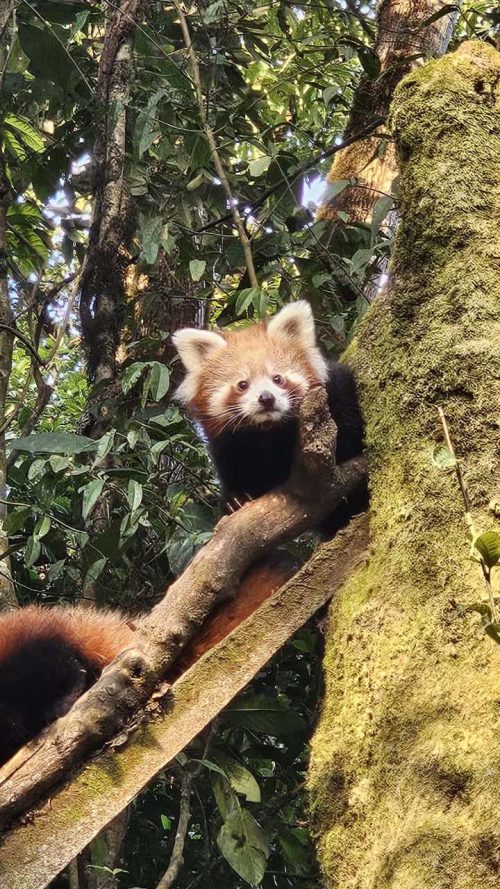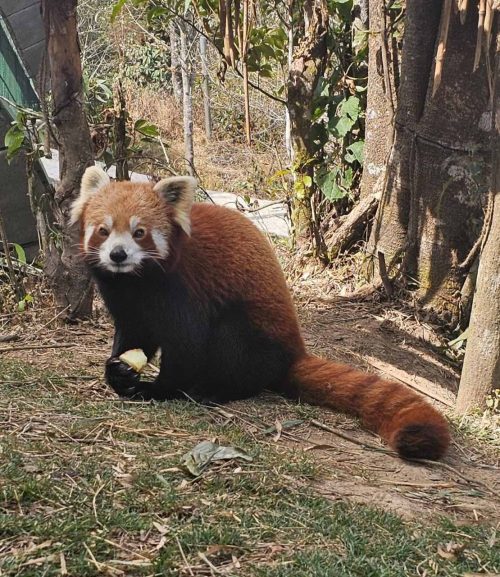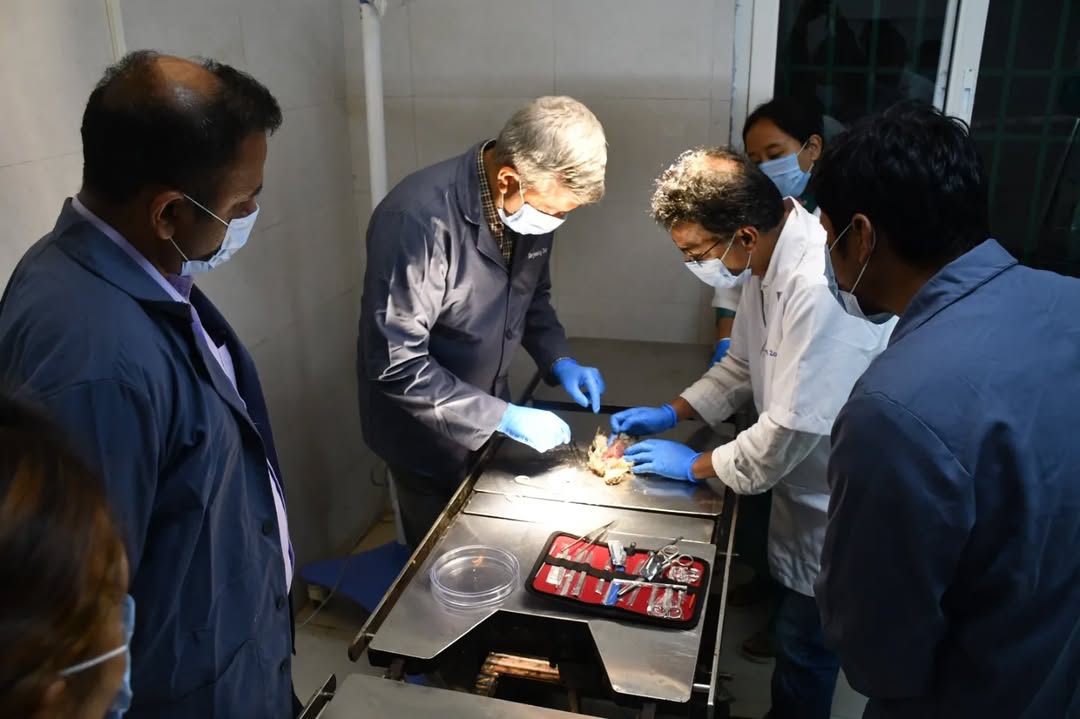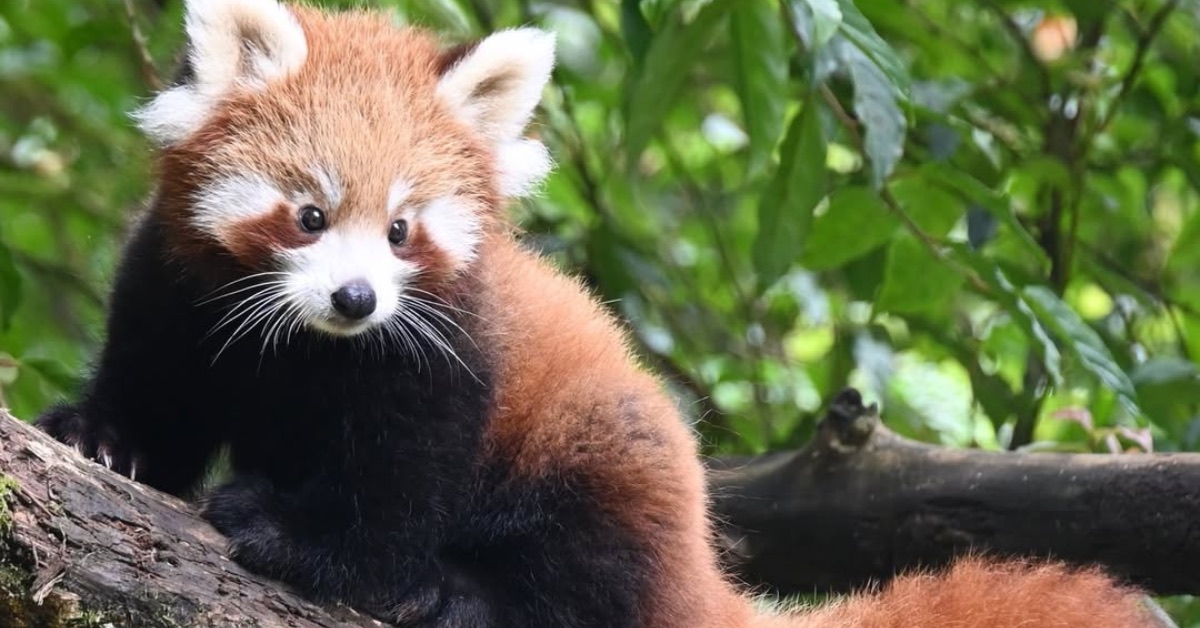Remember Master Shifu from Kung Fu Panda, Po’s wise teacher who helps him on his journey and, in pop culture, has immortalised the words ‘inner peace’?
Did you know his character is based on an animal that many call ‘the original panda’? With a more fox or raccoon-like appearance, the red panda was first described in 1825, decades before the discovery of the black-and-white roly-poly bear that comes to mind when we think of pandas.
So, what is the red panda anyway?
In the world of mammals, the red panda is a captivating enigma, the sole survivor of the Ailurus family (derived from the Greek word “Ailurus” meaning “cat”). Characterised by its lustrous red fur, ringed tail, and masked face, this unique creature belongs to the Carnivora order yet primarily dines on bamboo leaves.
Once widespread across Eurasia, red pandas now cling to a fragmented existence in the Eastern Himalayas.
Classified as ‘Endangered‘ by the International Union for Conservation of Nature (IUCN), facing a multitude of threats, several factors have contributed to their decline — habitat loss caused by human activities, a dip in genetic diversity that makes them prone to more illnesses, predators like leopards and feral dogs, and climate change.

“As red pandas don’t move much, there is a fragmentation of their population. Even though we say that their range extends from Western Nepal up to Arunachal, due to the fragmentation, there is no genetic exchange between these populations,” Dr Basavaraj Holeyachi, IFS, tells The Better India.
As the director of the Padmaja Naidu Himalayan Zoological Park (PNHZP) in Darjeeling, West Bengal, he has been leading the red panda conservation programme, which has gained international recognition over the years. In 2024, it was among the top three finalists for the World Association of Zoos and Aquariums (WAZA) Conservation and Environmental Sustainability Awards.
Darjeeling Zoo: A sanctuary in the hills
While a zoo, or zoological park, is often seen as an institute dedicated to exhibiting animals, it serves a much larger purpose — to study animals in captivity and through research and planning, make conservation efforts to aid their survival.
The Darjeeling Zoo is no exception, and in India, is the first zoo to have a genetic biobank facility.
Nestled in the heart of picturesque Darjeeling, just below the town’s popular Chowrasta Mall Road, the zoo serves as a vital hub for research and conservation, housing Himalayan species like the red panda, snow leopard, tahr, goral, and Siberian tigers.
“We are taking up several in-house and collaborative research initiatives of the species we host here, aiming to deepen our understanding and contribute to their conservation,” Dr Holeyachi says.
Notably, PNZHP has successfully bred 77 snow leopards since the 1980s, second only to the Bronx Zoo in New York.
“Presently we have 11 individuals in our facility,” Dr Holeyachi informs. “Other than that we are taking up conservation breeding of various Himalayan herbivores and pheasants.”
But it is the zoo’s red panda conservation programme that has grabbed most international attention.
“Red pandas are an iconic species of the Himalayan region,” Dr Holeyachi points out. The fact that Sikkim declared the red panda as its State Animal in the 1990s affirms his statement. In Darjeeling, too, the red panda has become an unofficial mascot.
Spotting a red panda
Spotting a red panda in the wild is a privilege. These shy creatures inhabit dense forests, favouring trees like oak, rhododendron, and magnolia.
“It is very rare that you’ll see a panda in the wild,” says Moumita Chakraborty, who has spent a little over three years researching red panda conservation and their habitats.
She explains that habitat loss remains among the most important contributors to the decline in the red panda population. “They are arboreal creatures and would mostly nap on trees. But you can only find them in regions that meet certain criteria is where you can find them,” she says.
“They prefer slopey hills with trees like the magnolia and of course, bamboo. Most of their diet consists of bamboo leaves. And for pandas to choose their habitats, a nearby water source remains key,” she adds.

“In the wild, we have two protected areas, the Singalila National Park and Neora Valley National Park, where red pandas thrive,” Dr Holeyachi informs. This is where the animals find their new home.
“From the zoo’s side, we take up conservation efforts to augment certain species whenever required, and the wildlife department works towards ensuring the conservation of the species in the wild,” he adds.
Guardians of the forest
Vishwanath Pratap, IFS, is in charge of three protected areas as the Darjeeling DFO (Wildlife Division). The Senchal Wildlife Sanctuary and Singalila National Park are home to 40-odd red pandas.
“Singalila is a dense, beautiful forest,” he says, adding, “It remains mostly untouched, even without our intervention.”
“We have installed a lot of camps, towers, all along the international boundary (with Nepal), and in some places deep inside the forest,” the Darjeeling (Wildlife) DFO explains. “We have 24×7 manning there. Even if it is very cold, even if it is raining, it is always manned.”
To prevent illegal activities like poaching, the forest rangers employ their local intelligence networks and most of the patrolling is done by foot. “The motorable road is only along the international boundary,” says Vishwanath.
“In places like Tonglu and Dhotre, red pandas sightings are reported now and then,” says J Sheikh Fareed, DFO (Darjeeling Territorial Division).
Tonglu and Dhotrey fall under the Singalila division and are popular tourist attractions, drawing hikers from all parts of the country. This region is marked by several small hamlets, criss-crossing the borders of Nepal and India.
“Conservation efforts are done with the help of locals,” Fareed explains. “People are very cooperative here. Through 81 Giant Forest Management Committees, we work extensively with them to conserve the forests,” he adds.
The Darjeeling Division DFO also points out that eco-tourism has, of late, become an important conservation strategy for the Forest Department.
“Lamahatta Eco Park is one of the most sought-after tourist destinations in Darjeeling. We generate around Rs 40 lakh in revenue every year, of which around 20-25% is given as share money to locals,” he exemplifies.
“In April, last year we organised the Singalila Bird Festival. We got several participants from all over India for a three-day birding experience,” says Vishwanath.
Rewilding red pandas
Aligned with the Darjeeling Forest Division’s commitment to habitat protection, the Padmaja Naidu Zoo plays a crucial role in research, breeding, and rewilding.
“The focus is not merely on rewilding, but on rewilding robust and genetically diverse populations. To achieve this, meticulous studies are conducted on the health and genetic fitness of the red pandas,” Vishwanath informs.
“We begin by carefully selecting individuals based on their pedigree and genetic diversity. Then, we implement a series of interventions to minimise the impact of human imprinting, ensuring they can adapt and survive in the wild,” Dr Holeyachi says.
“This includes training them to acquire the skills needed for independent survival. Only those individuals demonstrating the required behavioural competence are then released into a soft release facility, where they can gradually acclimate to the wilderness,” he adds.
Within the soft-release facility, a gradual shift occurs, transitioning red pandas from reliance on artificial food to a diet primarily consisting of natural resources. Once the red pandas have successfully acclimatised to a natural diet, they are released into the wild.
Biobank and genetic research
Barring externalities such as predators and poaching, an internal factor that has also contributed to the decline in red panda numbers is their nature. Red pandas are solitary creatures and prone to gene-related diseases due to inbreeding.
“Genetic diversity is the fundamental building block of a population, which means that the health of the population is dictated by it,” says Dr Karthikeyan Vasudevan, chief scientist for LaCONES (Laboratory for the Conservation of Endangered Species), an annexure of the Centre for Cellular and Molecular Biology (CCMB).
“It is like a Swiss army knife. You can do many things with it. If you have many tools in your genetic constitution, then you have a better ability to deal with diseases, anything that might happen to the population due to some infection and sudden climatic and natural disaster,” he adds.
And this is where the zoo’s genetic biobank comes into play. “Whatever individuals we are releasing, proper genetic analysis is being done through scientific institutions like CCMB. We release individuals with high genetic diversity and heterozygosity. That contributes to the genetic makeup of the population,” says Dr Holeyachi.
“Genetic resources like DNA, RNA, sperms, oocytes, or any other bodily tissues are valuable and can be biobanked. Preserved in liquid nitrogen at -196 deg C, they can remain alive for a very long time,” says Dr Vasudevan.

Biobanking of endangered species is gaining popularity across the world as a promising conservation tool. Apart from providing invaluable information that could aid in understanding susceptibility, reproductive success, and adaptation to environmental change, biobank gametes (sperm and eggs) can be used for assisted reproductive technologies like artificial insemination or in vitro fertilisation (IVF).
“Typically you can equate an endangered species to a person in an ICU. To help that person, you’ll have to give some support, put in some monitors, conduct tests, and check, and then give the possible best treatment so that that person recovers. This is exactly what we are doing with endangered species,” Dr Vasudevan says.
“We are bringing it, making sure we provide everything to ensure it successfully increases in numbers and can be given a home in the wild,” he adds.
LaCONES also helps Darjeeling Zoo plan its conservation breeding programmes by screening animals for diseases and providing information on the founder populations’ genetic makeup.
A holistic approach
All animals have a generation time — the period from birth to when they reach sexual maturity and produce their offspring. For red pandas, this is 18-20 months. But in the wild, numerous constraints impact this process: high mortality rates among the young, challenges in finding mates, potential food shortages after pregnancy, and predation.
Captive breeding programmes aim to mitigate these challenges by providing a controlled environment with adequate food and protection from predators, and by carefully selecting breeding pairs to maximise genetic diversity.

“So, even if you have seven individuals, you can bring its numbers up by actually planning over a period of time, slowly,” says Dr Vasudevan. “But these things don’t happen immediately. Sometimes it takes years,” he adds.
In the shadow of the majestic Himalayas, the red panda is not just a symbol of the region’s natural beauty, but also a barometer of the health of its fragile ecosystems. As Dr Holeyachi aptly puts it, “The ecosystem is an intricate and interconnected system where every species relies on others. Red pandas play a vital role within this ecosystem. By protecting red pandas, conservationists are simultaneously safeguarding their habitat and the diverse array of species that coexist within it. This integrated approach is crucial for the long-term conservation of the entire ecosystem.”
Edited by Megha Chowdhury; All images courtesy Padmaja Naidu Himalayan Zoological Park
